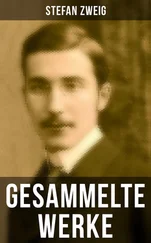Stefan Zweig - The Collected Stories of Stefan Zweig
Здесь есть возможность читать онлайн «Stefan Zweig - The Collected Stories of Stefan Zweig» весь текст электронной книги совершенно бесплатно (целиком полную версию без сокращений). В некоторых случаях можно слушать аудио, скачать через торрент в формате fb2 и присутствует краткое содержание. Год выпуска: 2013, ISBN: 2013, Издательство: PUSHKIN PRESS, Жанр: Классическая проза, на английском языке. Описание произведения, (предисловие) а так же отзывы посетителей доступны на портале библиотеки ЛибКат.
- Название:The Collected Stories of Stefan Zweig
- Автор:
- Издательство:PUSHKIN PRESS
- Жанр:
- Год:2013
- ISBN:9781782270706
- Рейтинг книги:4 / 5. Голосов: 1
-
Избранное:Добавить в избранное
- Отзывы:
-
Ваша оценка:
- 80
- 1
- 2
- 3
- 4
- 5
The Collected Stories of Stefan Zweig: краткое содержание, описание и аннотация
Предлагаем к чтению аннотацию, описание, краткое содержание или предисловие (зависит от того, что написал сам автор книги «The Collected Stories of Stefan Zweig»). Если вы не нашли необходимую информацию о книге — напишите в комментариях, мы постараемся отыскать её.
The Collected Stories of Stefan Zweig — читать онлайн бесплатно полную книгу (весь текст) целиком
Ниже представлен текст книги, разбитый по страницам. Система сохранения места последней прочитанной страницы, позволяет с удобством читать онлайн бесплатно книгу «The Collected Stories of Stefan Zweig», без необходимости каждый раз заново искать на чём Вы остановились. Поставьте закладку, и сможете в любой момент перейти на страницу, на которой закончили чтение.
Интервал:
Закладка:
Carefully, he took Esther’s hand and led her away from the picture. He did not speak, for he too felt warm tears coming to his eyes and did not want to show them. A warm radiance seemed to rest on her head as it did in the picture of the Madonna. It was as if something great beyond all words was in the room with them, rushing by on invisible wings. He looked into Esther’s eyes. They were no longer tearfully defiant, but shadowed only by a gentle reflective bloom. Everything around them seemed to him brighter, milder, transfigured. God’s sanctity, miraculously close, was revealing itself to him in all things.
They stood together like that for a long time. Then they began to talk as they used to do, but calmly and sensibly, like two human beings who now understood each other entirely and had no more to search for. Esther was quiet. The sight of the picture had moved her strangely, and made her happy because it restored the happiness of her dearest memory to her, because she had her baby back, but her feelings were far more solemn, deeper and more maternal than they had ever been in reality. For now the child was not just the outward appearance of her dream but part of her own soul. No one could take him away from her. He was all hers when she looked at the picture, and she could see it at any time. The old man, shaken by mystical portents, had willingly answered her desperate request. And now she could feel the same blessed abundance of life every day, her longings need no longer be timid and fearful, and the little childlike figure who to others was the Saviour of the world also, unwittingly, embodied a God of love and life to the lonely Jewish girl.
She visited the studio several more days running. But the painter was aware of his commission, which he had almost forgotten. The merchant came to look at the picture and he too, although he knew nothing about the secret miracles of its creation, was overwhelmed by the gentle figure of the Mother of God and the simple expression of an eternal symbol in its execution. He warmly shook hands with his friend, who, however, turned away his lavish praise with a modest, pious gesture, as if he were not standing in front of his own work. The two of them decided not to keep the altar deprived of this adornment any longer.
Next day the picture occupied the other wing of the altarpiece, and the first was no longer alone. And the pair of Madonnas, strangers but with a slight similarity, were a curious sight. They seemed like two sisters, one of them still confidently abandoning herself to the sweetness of life, while the other had already tasted the dark fruit of pain and knew a terror of times yet to come. But the same radiance hung over both their heads, as if stars of love shone above them, and they would take their path through life with its joy and pain under those stars.
Esther herself followed the picture to church, as if she found her own child there. Gradually the memory that the child was a stranger to her was dying away, and true maternal feelings were aroused in her, making her dream into reality. For hours on end she would lie prostrated before the painting, like a Christian before the image of the Saviour. But hers was another faith, and the deep voices of the bells called the congregation to devotions that she did not know. Priests whose words she could not understand sang, loud choral chanting swept like dark waves through the church, rising into the mystic twilight above the pews like a fragrant cloud. And men and women whose faith she hated surrounded her, their murmured prayers drowning out the quiet, loving words she spoke to her baby. However, she was unaware of any of that. Her heart was too bewildered to look around and take any notice of other people; she merely gave herself up to her one wish, to see her child every day, and thought of nothing else in the world. The stormy weather of her budding youth had died down, all her longings had gone away or had flowed into the one idea that drew her back to the picture again and again, as if it were a magical magnet that no other power could withstand. She had never been so happy as she was in those long hours in the church, sensing its solemnity and its secret pleasures without understanding them. She was hurt only when some stranger now and then knelt in front of the picture, looking adoringly up at the child who was hers, all hers. Then she was defiantly jealous, with anger in her heart that made her want to hit out and shed tears. At such moments her mind was increasingly troubled, and she could not distinguish between the real world and the world of her dreams. Only when she lay in front of the picture again did stillness return to her heart.
Spring passed on, the mild, warm weather in which the picture had been finished still held, and it seemed that after all her stormy suffering, summer too would give her the same great and solemn gift of quiet maternal love. The nights were warm and bright, but her fever had died away, and gentle, loving dreams came over Esther’s mind. She seemed to be at peace, rocking to a rhythm of calm passion as the regular hours went by, and all that had been lost in the darkness now pointed her ahead along a bright path into the future.
At last the summer approached its climax, the Feast of St Mary, the greatest day in Flanders. Long processions decked out with pennants blowing in the breeze and billowing banners went through the golden harvest fields that were usually full of busy workers. The monstrance held above the seed corn in the priest’s hands as he blessed it shone like the sun, and voices raised in prayer made a gentle sound, so that the sheaves in the fields shook and humbly bowed down. But high in the air clear bells rang in the distance, to be answered joyfully from church towers far away. It was a mighty sound, as if the earth itself were singing together with the woods and the roaring sea.
The glory of the day flowed back from the fertile land into the city and washed over its menacing walls. The noise of craftsmen at work died down, the day labourers’ hoarse voices fell silent, only musicians playing fife and bagpipes went from street to street, and the clear silvery voices of dancing children joined the music-making. Silken robes trimmed with yellowing lace, kept waiting in wardrobes all the last year, saw the light of day again, men and women in their best clothes, talking cheerfully, set out for church. And in the cathedral, with its doors open to invite in the pious with clouds of blue incense and fragrant coolness, a springtime of scattered flowers bloomed, pictures and altars were adorned with lavish garlands made by careful hands. Thousands of candles cast magical light into the sweet-scented darkness where the organ roared, and singing, mysterious radiance and mystical twilight reached the heights and depths of the great building.
And then, suddenly a pious and God-fearing mood seemed to flow out into the streets. A procession of the devout formed; up by the main altar the priests raised the famous portrait of St Mary, which seemed to be surrounded by whispered rumours of many miracles, it was borne aloft on the shoulders of the pious, and a solemn procession began. The picture being carried along brought silence to the noisy street, for the crowd fell quiet as people bowed down, and a broad furrow of prayer followed the portrait until it was returned to the cool depths of the cathedral that received it like a fragrant grave.
That year, however, the pious festival was under a dark cloud. For weeks the country had been bearing a heavy burden. Gloomy and as yet unconfirmed news said that the old privileges were to be declared null and void. The freedom fighters known as the Beggars who opposed Spanish rule were making common cause with the Protestants. Dreadful rumours came from the countryside of Protestant divines preaching to crowds of thousands in open places outside the towns and cities, and giving Communion to the armed citizens. Spanish soldiers had been attacked, and churches were said to have been stormed to the sound of the singing of the Geneva Psalms. There was still no definite word of any of this, but the secret flickering of a coming conflagration was felt, and the armed resistance planned by the more thoughtful at secret meetings in their homes degenerated into wild violence and defiance among the many who had nothing to lose.
Читать дальшеИнтервал:
Закладка:
Похожие книги на «The Collected Stories of Stefan Zweig»
Представляем Вашему вниманию похожие книги на «The Collected Stories of Stefan Zweig» списком для выбора. Мы отобрали схожую по названию и смыслу литературу в надежде предоставить читателям больше вариантов отыскать новые, интересные, ещё непрочитанные произведения.
Обсуждение, отзывы о книге «The Collected Stories of Stefan Zweig» и просто собственные мнения читателей. Оставьте ваши комментарии, напишите, что Вы думаете о произведении, его смысле или главных героях. Укажите что конкретно понравилось, а что нет, и почему Вы так считаете.












